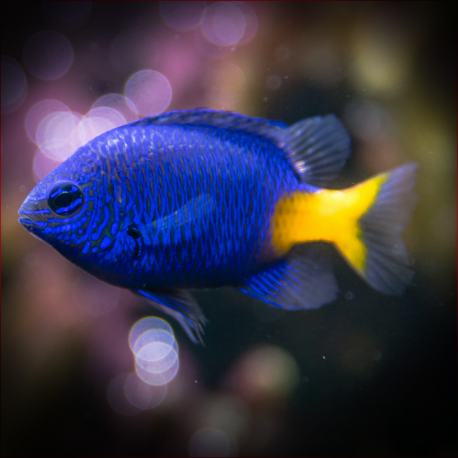More info
Datasheet
| Minimum Tank Size | 150 litres / 39.63 US gallons |
| Maximum Size | 7.0cm / 2.76inches |
| Reef Compatible | Always reef safe |
| Temperament | Peaceful |
| Temperature | 22.2°C / 71.96°F - 25.6°C / 78.08°F |
| Specific Gravity | 1.020-1.025 |
| Carbonate Hardness | 8-12 |
| pH | 8.1-8.4 |
General Description:The Yellowtail Damselfish, scientifically known as Chrysiptera parasema, belongs to the Pomacentridae family. These fish are part of a genus of Damselfish renowned for their vibrant colors, with some species exhibiting peaceful behavior while others can be quite aggressive.
Aquarium Suitability:Yellowtail Damselfish are suitable for most aquarium setups, known for their peaceful temperament and hardiness. They can coexist as a pair if introduced simultaneously, requiring ample hiding places such as live rocks within the tank. These fish can thrive in a community with their own kind, given there is sufficient space provided.
Care and Hardiness:Considered hardy, Yellowtail Damselfish are relatively easy to care for in captivity. They are compatible with a variety of tank mates but should not be kept with very peaceful or docile species due to their territorial nature.
Reef Suitability:Yellowtail Damselfish are always considered reef safe, making them an excellent choice for reef aquarium setups. They need hiding places within the reef structure to feel secure.
Aquarium Setup:Maintaining water parameters within the range of pH 8.1-8.4, dKH 8-12, salinity of 1.020-1.025, and a temperature of 22.2-25.6°C (72-78°F) is crucial for the well-being of Yellowtail Damselfish. A tank size of at least 150 liters with plenty of hiding spots is recommended.
Behaviour:These fish exhibit a peaceful temperament within the aquarium, especially when provided with enough space and hiding spots. However, they can be territorial, so it's best to keep only one Yellowtail Damselfish per tank unless in a very large setup.
Feeding and Diet:Yellowtail Damselfish thrive on a diet of microalgae like spirulina, small crustaceans such as krill and mysis shrimp, and zooplankton like cyclops and pods. Feeding them multiple times a day with a varied diet is ideal for their health.
Dimorphism:Yellowtail Damselfish do not exhibit significant dimorphism, and they can be bred in captivity. Captive breeding programs contribute positively to the availability of healthy specimens in the aquarium trade.
Habitat and Distribution:These fish are native to the Western Pacific region, including areas like the Solomon Islands, northern Papua New Guinea, the Philippines, and the Ryukyu Islands. There are doubts regarding their presence in the Great Barrier Reef, off Cairns, Australia.

